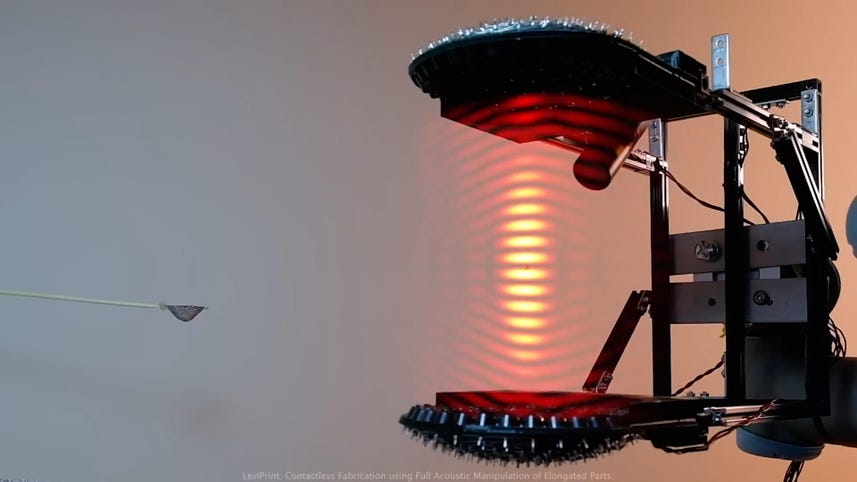
Speaker 1: A new device called levy print uses soundwaves to levitate and manipulate objects for touch free building. We spoke to one of the researchers behind levy print to learn more about how it works, what it's capable of and how it could be put to use. Let's check it out.
Speaker 2: Levi print is a system that can levitate, manipulate different objects to assemble complex pieces. [00:00:30] Of course, these objects could be small spheres, but also, uh, droplets of glue and cure it whenever we want without the violet and the most important thing. And the most novel thing is that we can levitate move and rotate sticks.
Speaker 1: The levitation is created by sound waves that have a frequency, approximately double the highest frequency that we humans can hear.
Speaker 2: When you create these sound fields, uh, they have different shapes. Yeah. They usually have like a wavy pattern. And when you put small objects, they get trapped in this [00:01:00] standard wave.
Speaker 1: In levy prints video, you can see the interference patterns created by the soundwaves
Speaker 2: Dark areas like black. It's like, uh, low amplitude. Or if we talk about some low volume areas that are brighter, that's high intensity, and you can see that the particles, they tend to go to the low amplitude areas.
Speaker 1: These low amplitude areas are good for trapping and manipulating objects like spheres or glue droplets. But when elongated objects like sticks get involved, it gets more complicated.
Speaker 2: When you levitate small particles [00:01:30] or a droplet of glue, it looks like a, like a pair of fingers. It holds the, the particle there. But when we levitate sticks with tested different methods and some things, they look like the two pairs of fingers, all there look like a, like if you were like holding like a sandwich, but they wanted work the best while like having like two traps at the sides of the stick. Not exactly at the size, but with an offset of the one millimeter or something like that.
Speaker 1: The video released by levy print shows the device using sticks, spheres and UV curable, [00:02:00] blue droplets to build a variety of different shapes structures and this orange cat thing. But why might someone want to build using acoustic levitation rather than say another method?
Speaker 2: There are mainly three advantages of using acoustic levitation to assemble objects. A robot could hold something, but then if it's going to hold another material, another path, maybe you need to change the twist or otherwise, uh, [00:02:30] you will. Cross-contaminate the pieces. So acoustic limitation is cool because it minimizes cross-contamination another advantage is that with the same levitator with the same end factor, you can manipulate a variety of things. You can manipulate sticks, you can manipulate particles, you can manipulate glue and you don't need to swap up the let's say the holder. And the third one is you can move these parts, uh, through holes and cavities
Speaker 1: Asie tells me that this levy print technology could be useful in the biomedical field where they're worried [00:03:00] about cross-contamination or in manufacturing, things like watches or phone cameras due to their small and sensitive parts. But it'll probably be a while before we see anything like levy print being used commercially,
Speaker 2: Maybe for calling 3d printer, it would need to be a more developed prototype. Yeah. Like there is a process, uh, system that we give to somebody and they know how to put their 3d model. There will be a software that will slice it or calculate or divide it into pass and then plan the limitation of those parts. And then the, the system will assemble this object and [00:03:30] so far, okay. We have some working principles for that, some basic pieces to achieve that, but it still would need more software and engineering.